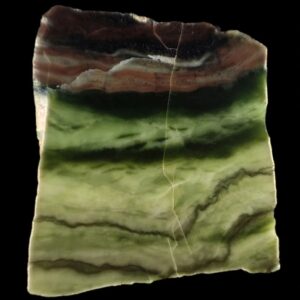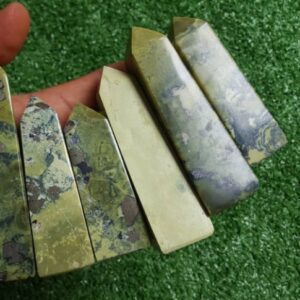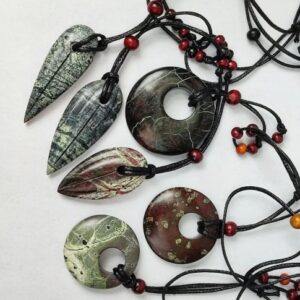Serpentine is used as a gemstone, carving material, architectural stone, and a source of asbestos.
You’re probably most familiar with the apple-green to-black color with light and dark-colored mottled areas. Their surfaces often have a wax-like or shiny appearance with a soapy feel. Serpentine is usually fine-grained and compact but can be granular, fibrous, or platy in appearance. The term ‘Serpentine’ is most commonly used by the public to refer to a rock type geologists call Serpentinite.
If you’re looking to collect Serpentine then you’re in luck because California and Nevada have large deposits.
Serpentine primarily comprises one or more of the three Magnesium Silicate minerals: Chrysolite, Antigorite, and Lizardite. Chrysolite often occurs as fibrous veinlets in Serpentine. In this fibrous form, Chrysolite is the most common type of asbestos. Lizardite and Antigorite do not form asbestos fibers. Instead, they are plate-like in form.
Because Serpentine often contains some amount of asbestos, and the exposure to asbestos fibers has potential health consequences, there are regulations restricting the use of Serpentine as an unpaved road surfacing material.

Serpentine Mineral
Serpentine isn’t the name of one single mineral. Instead, it’s a name used for a large group of minerals.
This stone’s most prominent physical properties are its beautiful green color, slippery feel, and patterned appearance. The rocks are incredibly reminiscent of a snake, hence the name Serpentine. This stone is known for its translucent diaphaneity, ease of being cut into shapes, its ability to accept a polish, and waxy luster.
These properties make Serpentine a popular gemstone, ornamental stone, and architectural material.
Serpentine’s ability to resist heat transfer makes it an incredibly valuable insulator. Fibrous varieties, like Chrysolite, have been used to make asbestos for many industrial uses. However, its uses today are limited because asbestos fibers are associated with respiratory diseases.
Serpentine Hardness
Serpentine has various hardness. It can be a 3, 4, or 5 on the Mohs Hardness Scale. That might seem confusing, but it is due to Serpentine’s composition of various minerals. One fine example is that the hardness of the natural stone varies based on the particular group of minerals in which each slab is made.

Serpentine Parent Rock
Serpentine is considered to be the metamorphosed remains of Magnesium-rich igneous rocks. Most commonly, the stone’s parent rock is Peridote, from the Earth’s mantle.
Serpentine minerals often form by the hydration of Olivine-rich Ultramafic rocks at relatively low temperatures. The chemical reaction naturally turns Olivine into Serpentine minerals. These stones may often have their origins in metamorphic alterations of Pyroxene and Peridotite.
Where Is Serpentine Found?
As mentioned above, Serpentine is found in northern and central California.
In the Northern US, Serpentine soils are also present in small yet widely distributed areas along the eastern slope of the Appalachian Mountains in the eastern US and in the Pacific Ranges of Oregon.
Serpentinite vs Serpentine
Serpentinites are metamorphic rocks that are primarily composed of Serpentine group minerals. The serpentine group minerals we mentioned above are produced by the hydrous alteration of ultramafic rocks. These igneous rocks are formed of Pyroxene and Olivine. Serpentine group minerals occur less commonly in some Olivine-bearing marbles and Kimberlites. Still, they are typically not considered to be Serpentine stones.
How Is Serpentine Formed?
Serpentine rocks form as the result of serpentinization. These chemical reactions convert anhydrous Ferromagneisian Silicate minerals (Olivine, Pyroxene) into hydrous Silicate minerals (Serpentine), with the possibility of also producing Magnetite and Brucite.
Brucite forms the precursor rocks, rich in Magnesium. Magnetite forms if there’s enough Iron present. Usually, Serpentine contains Iron in the form of Magnetite, which produces a dark color in Serpentinites.
Serpentine is fairly common below the Earth’s crust but it’s not nearly as common in the upper parts of the Earth’s crust. It occurs mainly where ultramafic rocks are found. Serpentine minerals, along with other green-colored alteration minerals like Chlorite and Talc, are still relatively widely distributed because Olivine and Pyroxenes are readily available.
Serpentine Cleavage
One identifying characteristic of Serpentine is its cleavage. Serpentine has an almost perfect cleavage which is not very common among most rocks.

Serpentine Stone Price
Because Serpentine is common and widely abundant, it’s reasonably affordable. Smaller gemstones cut en cabochon can range between 20 cents to $2.75 per carat. Beads can range somewhere between 7 cents and 27 cents per carat.
The prices will always fluctuate yearly, but the more common minerals and stones are, the lesser their value on the selling end. However, jewelry seems to usually sell for higher amounts, but that depends on the style of the cut and quality of the jewelry. Some collectors will pay higher prices for larger specimens of excellent quality, but that might take a bit of searching. Check around at local jewelers, gem and mineral societies, and rockhounding clubs for updated pricing.
- Identify Enstatite - March 12, 2024
- Identify Cerussite - March 3, 2024
- Identify Bytownite - February 18, 2024
